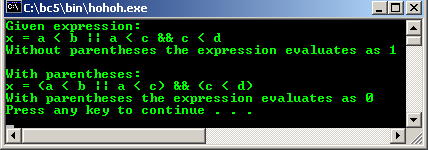|< C/C++ Statements, Expressions & Operators 1 | Main | C/C++ Statements, Expressions & Operators 3 >| Site Index | Download |
MODULE 3a
MORE ON C/C++ STATEMENTS, EXPRESSIONS
AND OPERATORS 2
My Training Period: xx hours
The source code for this Module is: Module 3 C/C++ source codes. and the related worksheet for your practice is: C lab worksheets 5.
The C and C++ skills: Able to understand and use:
-
Relational Operator.
-
Expression and if Statement.
-
Relational Expressions.
-
Precedence of Relational Operators.
-
Logical Operators.
-
True and False Values.
-
Precedence of Logical Operators.
-
Compound Assignment Operators.
|
| 3.6 Relational Operators
3.6.1 Expressions And The if Statement
| |||||||||||||||||||||||||||||||||||||||||||||||
3.6.2 A Program Control Statement: An Introduction
-
Modifies the order of the statement execution.
-
Can cause other program statements to execute multiple times or not to execute at all, depending on the circumstances, condition imposed.
-
Other type of program control includes do, for and while that will be explained in detail in another Module.
-
This section introduced because many relational and logical operators are used in the expression of the program control statements.
-
The most basic if statement form is:
| if ( expression ) statement(s); |
| next_statement; |
Evaluate an expression and directs program execution depending on the result of that evaluation.
If the expression evaluate as TRUE, statement(s) is executed, if FALSE, statement(s) is not executed, execution then passed to the code follows the if statement, that is the next_statement.
So, the execution of the statement(s) depends on the result of expression.
-
if statement also can control the execution of multiple statements through the use of a compound statement or a block of code. A block is a group of two or more statements enclosed in curly braces, { }.
-
Typically, if statements are used with relational expressions, in other words, "execute the following statement(s) only if a certain condition is true".
-
For example:
| if ( expression ) { statement1; statement2; ... ... statement-n; } |
| next_statement; |
-
A program example:
// demonstrates the use of the if statements
#include <stdio.h>
int main()
{
int x, y;
// input the two values to be tested
printf("\nInput an integer value for x: ");
scanf("%d", &x);
printf("Input an integer value for y: ");
scanf("%d", &y);
// test values and print result
if (x == y)
{
printf("\nx is equal to y");
}
if (x > y)
{
printf("\nx is greater than y");
}
if (x < y)
{
printf("\nx is smaller than y");
}
printf("\n\n");
return 0;
}
Possible outputs:
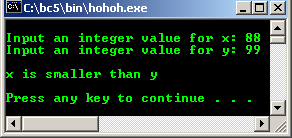
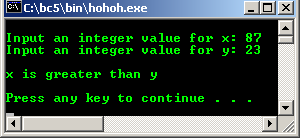
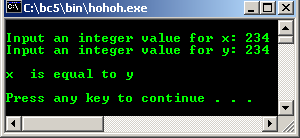
-
We can see that this procedure is not efficient. Better solution is to use if–else statement as shown below:
| if ( expression ) statement1; else statement2; |
| next_statement; |
-
The expression can be evaluated to TRUE or FALSE. The statement1 and statement2 can be compound or a block statement.
-
This is called a nested if statement. Nesting means to place one or more C/C++ statements inside another C/C++ statement.
-
A program example:
// demonstrates the use of if-else statement
#include <stdio.h>
int main()
{
int x, y;
// input two values to be tested
printf("\nInput an integer value for x: ");
scanf("%d", &x);
printf("Input an integer value for y: ");
scanf("%d", &y);
// test the values and print result
if (x == y)
{
printf("\nx is equal to y");
}
else if (x > y)
{
printf("\nx is greater than y ");
}
else {
printf("\nx is smaller than y ");
}
printf("\n\n");
return 0;
}
Possible outputs:
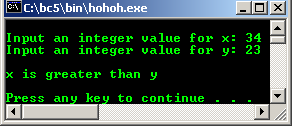
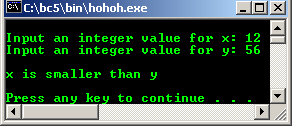
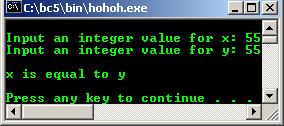
-
Keep in mind that we will learn if–else statements more detail in program controls Module. As a pre-conclusion, there are 3 form of if statements.
Form 1:
| if ( expression ) statement1; |
| next_statement; |
Form 2:
| if ( expression ) statement1; else statement2; |
| next_statement; |
Form 3:
| if ( expression ) statement1; else if ( expression ) statement2; else if ( … ) statement3; … … … else statementN; |
| next_statement; |
3.7 Relational Expressions
-
Expression using relational operators evaluate, by definition, to a value of either FALSE (0) or TRUE (1).
-
Normally used in if statements and other conditional constructions.
-
Also can be used to produce purely numeric values.
-
Another program example:
// demonstrates the evaluation of relational expression
#include <stdio.h>
int main()
{
int a;
// evaluates to 1, TRUE
a = (5 == 5);
printf ("\na = (5 == 5)\n Then a = %d\n", a);
// evaluates to 0, FALSE
a = (5 != 5);
printf ("\na = (5 != 5)\n Then a = %d\n", a);
// evaluates to 1 + 1, TRUE
a = (12 == 12) + (5 != 1);
printf("\na = (12 == 12) + (5 != 1)\n Then a = %d\n", a);
return 0;
}
Output:
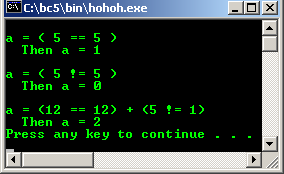
-
x = 5, evaluates as 5 and assigns the value 5 to x. This is an assignment expression.
-
x == 5, evaluates as either 0 or 1 (depending on whether x is equal to 5 or not) and does not change the value of x. This is comparison expression.
-
Consider this, the wrong usage of the assignment operator ( = ),
if(x = 5)
printf("x is equal to 5");
-
The message always prints because the expression being tested by the if statement always evaluates as TRUE, no matter what the original value of x happens to be.
-
Referring to the above example, the value 5 does equal 5, and true (1) is assigned to 'a'. "5 does not equal 5" is FALSE, so 0 is assigned to 'a'.
-
As conclusion, relational operators are used to create relational expression that asked questions about relationship between expressions. The answer returned by a relational expression is a numeric value 1 or 0.
3.7.1 Precedence of Relational Operators
-
Similar to mathematical operators, in case when there is multiple operator expression.
-
Parentheses can be used to modify precedence in expression that uses relational operators.
-
All relational operators have a lower precedence than all mathematical operators.
-
For example:
(x + 2 > y)
-
Better written like this:
((x + 2) > y)
| Operators | Relative precedence |
| < <= > >= | 1 |
| != == | 2 |
|
Table 3.6: Precedence of the relational operators | |
-
For example:
x == y > z equivalent to x == (y > z)
-
Avoid using the “not equal to” operator ( != ) in an if statement containing an else, use “equal to” ( == ) for clarity.
-
For example:
if(x != 5)
statement1;
else
statement2;
-
So, better written as:
if(x == 5)
statement2;
else
statement1;
3.8 Logical Operators
-
C / C++ logical operators enable the programmer to combine 2 or more relational expressions into a single expression that evaluate as either TRUE (1) or FALSE (0).
| Operator | Symbol | Example |
| AND | && | expression1 && expression2 |
| OR | || | expression1 || expression2 |
| NOT | ! | !expression1 |
|
Table 3.7: Logical operators | ||
| Expression | Evaluates As |
| (expression1 && expression2) | True (1) only if both expression1 and expression2 are true; false (0) otherwise. |
| (expression1 || expression2) | True (1) if either expression1 or expression2 is true; false (0) only if both are FALSE. |
| (! expression1) | False (0) if expression1 is true; true (1) if expression1 is true. |
|
Table 3.8: Evaluation of the logical expressions | |
-
These expressions use the logical operators to evaluate as either TRUE or FALSE depending on the TRUE/FALSE value of their operands.
-
For example:
| Expressions | Evaluates As |
| (5 == 5) && (6 != 2) | True (1) because both operands are true |
| (5 > 1) || (6 < 1) | True (1) because one operand is true |
| (2 == 1) && (5 == 5) | False (0) because one operand is false |
| ! (5 == 4) | True (1) because the operand is false |
| NOT (FALSE) = TRUE | |
|
Table 3.9: Examples of logical expressions | |
-
For AND and OR operator are summarized in the following Tables:
| Operand1 | Operand2 | Output |
| 0 | 0 | 0 ( F ) |
| 0 | 1 | 0 ( F ) |
| 1 | 0 | 0 ( F ) |
| 1 | 1 | 1 ( T ) |
|
Table 3.10: Logical AND Operation | ||
| Operand1 | Operand2 | Output |
| 0 | 0 | 0 ( F ) |
| 0 | 1 | 1 ( T ) |
| 1 | 0 | 1 ( T ) |
| 1 | 1 | 1 ( T ) |
|
Table 3.11: Logical OR Operation | ||
3.8.1 TRUE And FALSE Values
-
For relational expression, 0 is FALSE, 1 is TRUE
-
Any numeric value is interpreted as either TRUE or FALSE when it is used in a C / C++ expression or statement that is expecting a logical (true or false) value.
-
The rules:
▪ A value of 0, represents FALSE.
▪ Any non zero (including negative numbers) value represents TRUE.
-
For example:
x = 125;
if(x)
printf("%d", x)
3.8.2 Precedence of Logical Operators
#include <stdio.h>
int main() { // initialize variables and note that c is not less than d, which is one of the conditions to test for // therefore the entire expression should be evaluated as false int a = 5, b = 6, c = 5, d = 1; int x; // evaluate the expression without parentheses x = a < b || a < c && c < d; // Form 1 printf("Given expression:\n"); printf("x = a < b || a < c && c < d\n"); printf("Without parentheses the expression evaluates as %d", x); // evaluate the expression with parentheses x = (a < b || a < c) && (c < d); // Form 2 printf("\n\nWith parentheses:\n"); printf("x = (a < b || a < c) && (c < d)\n"); printf("With parentheses the expression evaluates as %d\n", x); return 0; }
Output:
|
|
-
From the above example, we are given 3 conditions:
-
Is a less than b? , a < b // Condition 1
-
Is a less than c? , a < c // Condition 2
-
Is c less than d? , c < d // Condition 3
-
Condition 1 logical expression that evaluate as true if condition 3 is true and if either condition 1 or condition 2 is true. But this do not fulfill the specification because the && operator has higher precedence than ||, the expression is equivalent to a < b || (a < c && c < d) and evaluates as true if (a < b) is true, regardless of whether the relationships (a < c) and (c < d) are true.
3.9 Compound Assignment Operators
-
For combining a binary mathematical operation with an assignment operation.
-
There is shorthand method.
-
For example:
x = x + 5;
→ x += 5;
-
The general notation is:
expression1 = expression1 operator expression2
-
The shorthand method is:
expression1 operator = expression2
-
The examples:
| Expression | Equivalent |
| x *= y | x = x * y |
| y -= z + 1 | y = y – (z + 1) |
| a / = b | a = a / b |
| x += y / 8 | x = x + (y / 8) |
| y %= 3 | y = y % 3 |
|
Table 3.12: Examples of compound assignment operator | |
-
Another example:
If x = 12;
Then,
z = x += 2;
z = x = x + 2
= 12 + 2
= 14
-
Program example:
#include <stdio.h>
int main()
{
int a = 3, b = 4;
printf("Initially: a = 3, b = 4\n");
printf("\na += b ---> a = a + b = %d\n", a+=b);
printf("a last value = %d\n", a);
printf("\na *= b ---> a = a * b = %d\n", a*=b);
printf("a last value = %d\n", a);
printf("\na -= b ---> a = a - b = %d\n", a-=b);
printf("a last value = %d\n", a);
printf("\na/=b ---> a = a / b = %d\n", a/=b);
printf("a last value = %d\n", a);
printf("\na-=(b+1)---> a = a - (b + 1) = %d\n", a-=(b+1));
printf("a last value = %d\n", a);
return 0;
}
Output:

3.10 The Conditional Operators
-
The C / C++ only ternary operator, it takes 3 operands.
-
The syntax:
Expression1 ? expression2 : expression3;
-
If expression1 evaluates as true (non zero), the entire expression evaluated to the value of expression2. If expression1 evaluates as false (zero), the entire expression evaluated to the value of expression3.
-
For example:
x = y ? 1 : 100;
Assign value 1 to x if y is true.
Assign value 100 to x if y is false.
-
It also can be used in places an if statement cannot be used, such as inside a single printf() statement. For example:
z = (x > y)? x : y;
-
Can be written as:
if(x > y)
z = x;
else
z = y;
-
A program example.
#include <stdio.h>
int main()
{
int a, b = 4, c= 50;
// here b is less than c, so the statement
// (b>c) is false, then 200 should be assigned
// to a, reflected through the output
a = (b>c) ? 100 : 200;
printf("Given: b = 4, c= 50\n");
printf("The statement:a = (b>c) ? 100 : 200\n");
printf("will be evaluated to a = %d\n", a);
return 0;
}
Output:
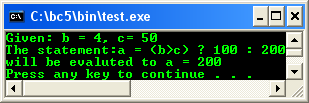
-
Change the (b>c) to (b<c), then recompile and rerun. Notice the output difference.
Related C and C++ reading and digging:
-
The source code for this Module is: Module 3 C/C++ source codes. and the related worksheet for your practice is: C lab worksheets.
